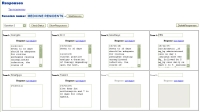KU Responder Audience Response System and online Delphi
"How drearily in College hall
The Doctor stretched the hours,"
Emerson RW. Walden. 1867.
Screen shots of displaying the responses: |
Contents:Uses:
Access: About: |
Uses
1. Audience Response System
The Internet has transformed information retrieval in the health sciences. Consequently, many health libraries have created computer classrooms to teach information retrieval in a practical, hands-on manner. However, bringing the Internet into the classroom provides new distractions for the students (Guernsey 2004; Schwartz 2003).
Team Learning (TL) is a method of increasing student engagement (Kelly 2005) teaching content by dividing learners into groups that complete tasks. An essential principle of team learning is characterized by the “three Ss” of the tasks that are assigned (Michaelson 2005):
- same problem, case, or question for each group
- simultaneously reporting of group responses
- making a specific choice. This restriction allows simultaneous reporting because the instructor can poll a show of hands as to which choice groups made.
Use of an audience response system (ARS) allows simultaneous reporting of responses while not restricting answers to a specific choice. This is because the ARS allows simulataneous revealing of answers that may be in the format of a short paragraph. The ARS also can display a bar graph of forced choice answers in the format T/F, Y/N, 1 through 5, A through E.
Please contact rbadgett@kumc.edu to use this system. You may either use our version, or download the files from Sourceforge and install on your own server.
2. Group decision making
a. Online Delphi system
The Delphi method can improve group decision making (5,6,7,8,9). The ARS can facilitate mini-Delphi even if users are geographically scattered on a conference call. Each participant can display the group's responses on their own Internet browser after the facilitator notes that all responses have been recieved.
Please contact rbadgett@kumc.edu to use this system.
b. Online Nominal Group Technique
Nominal Group Technique (Jones) is another method of group decision making. As compared to the Delphi in which items are scored by members, in NGT items are ranked by members.
The two methods of group decision making have been compared (Hutchings, Fretheim).
b. Hybrid Technique
Access
1. Audience/participants access
2. Instructor/facilitator access
The interface allows the instructor to check whether all groups have submitted a response and allows the instructor to reveal all responses to the classroom at once.
About
1. Funding
- 7/2007: UTHSCSA Scholarship of Teaching Grant (PI: Bob Badgett)
- 9/2007: UT Academy of Health Science Education Small Grant (PI: Glen Medellin)
2. History
The UT Responder was initially developed for use in February, 2006 for an evidence-based medicine class that used team and distance learning. It was named UT Responder, or UTXR for short, in September, 2008.
3. Presentations
- 2/2009: UT Innovations in Health Science Education Conference
- 3/2009: Team-based Learning 2009 Conference
References
- Anonymous. The Delphi Method (Accessed 2/1/2007)
- Badgett RG, Stone J, Collins TC. The importance of free-text responses in team-based learning design. Acad Med. 2014 Dec;89(12):1578. doi: 10.1097/ACM.0000000000000512. PMID: 25423152
- Brown BB "Delphi Process: A Methodology Used for the Elicitation of Opinions of Experts.", RAND (Document No: P-3925, 1968, 15 pages) (Accessed 2/1/2007)
- Davies S, Romano PS, Schmidt EM, Schultz E, Geppert JJ, McDonald KM. Assessment of a novel hybrid Delphi and Nominal Groups technique to evaluate quality indicators. Health Serv Res. 2011 Dec;46(6pt1):2005-18. doi: 10.1111/j.1475-6773.2011.01297.x. Epub 2011 Jul 25. PMID: 21790589.
- Fink A, Kosecoff J, Chassin M, Brook RH. Consensus methods: characteristics and guidelines for use. Am J Public Health. 1984 Sep;74(9):979-83. PMID: 6380323 Fulltext (pdf)
- Fitch K et al. The Rand UCLA Appropriateness Method User's Manual. 2000 Oct. ISBN/EAN: 0-8330-2918-5 PDFs at RAND
- Fretheim A, Schunemann HJ, Oxman AD. Improving the use of research evidence in guideline development: 5. Group processes. Health Res Policy Syst. 2006 Dec 1;4:17. PMID: 17140442
- Guernsey L. When Gadgets Get in the Way. New York Times 2004 August 19, 2004. http://www.nytimes.com/2004/08/19/technology/circuits/19teac.html
- Hutchings A, Raine R, Sanderson C, Black N. A comparison of formal consensus methods used for developing clinical guidelines. J Health Serv Res Policy. 2006 Oct;11(4):218-24. PMID: 17018195
- Jones J, Hunter D. Consensus methods for medical and health services research. BMJ. 1995 Aug 5;311(7001):376-80. PMID: 7640549
- Kelly PA, Haidet P, Schneider V, Searle N, Seidel CL, Richards BF. A comparison of in-class learner engagement across lecture, problem-based learning, and team learning using the STROBE classroom observation tool. Teach.Learn.Med. 2005 Spring;17(2):112-118. PMID: 15833720
- Linstone HA, Turoff M. "The Delphi Method: Techniques and Applications" 1975. (Accessed 2/1/2007)
- Michaelsen L, Richards B. Drawing conclusions from the team-learning literature in health-sciences education: a commentary. Teach.Learn.Med. 2005 Winter;17(1):85-88. PMID: 15691820
- Regan-Smith MG, Obenshain SS, Woodward C, Richards B, Zeitz HJ, Small PA Jr. Rote learning in medical school. JAMA. 1994 Nov 2;272(17):1380-1. PMID: 7933403.
- Schwartz J. Professors Vie With Web for Class's Attention. New York Times 2003 January 2, 2003. http://www.nytimes.com/2003/01/02/technology/02WIRE.html

